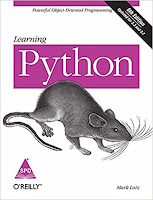[Reading Time: 3 to 5 minutes]
[Edited] Reposting this as i have decided to change the book.
[Edited] Reposting this as i have decided to change the book.
Looks like programming languages are sweeping the internet today. Ever since the programming languages were introduced, the pace of new languages was rising gradually. Today, we are seeing a higher pace of several new and promising languages. Python and Go seem to take up cloud software development quite strongly. Python has been around for a lot of time. Go seems to pick up - offering ease of development comparable to languages like Python and giving a speed of execution of that of C/C++. From now and for next few months, I have to ride two horses - learning both Python and Go. I have to admit that I cannot put off my temptation (which I kept off for last three months).
 |
| Go in Action by William Kennedy and Others |
It consists of 9 chapters (270 pages). The chapters are said to be designed in such a way that an intermediate programmer can get best out of it (the audience the folks with some programming experience but new to Go, so no boring stuff). This is a quite a promise to keep up. I am excited to ride two horses.
Let us see how it goes. I am excited to learn Go and share my reading journal with you on Go :-)
There is another language that is creating so much noise - Rust. Check it out. If you are a C guy, you have to watch out Rust (hoping that I will not jump the gun in learning Rust)
Note 1: You will see "Reading Time" in all my posts. I want to alert you how much time you are likely to invest reading my posts so that you can decide when and whether to read the post.
Note 2: My goal is to keep it short and give you links in every page to read posts relevant each post
[Update after reading first chapter and reading the second chapter after half way through]
Looks to me that Go In Action has taken the learning in a different perspective and I am certainly feeling little tired to get past each sections. Somehow, I feel this should not be my first book on Go and I am going to switch to another book - which probably offers step by step in small increments.
Note 1: You will see "Reading Time" in all my posts. I want to alert you how much time you are likely to invest reading my posts so that you can decide when and whether to read the post.
Note 2: My goal is to keep it short and give you links in every page to read posts relevant each post
[Update after reading first chapter and reading the second chapter after half way through]
Looks to me that Go In Action has taken the learning in a different perspective and I am certainly feeling little tired to get past each sections. Somehow, I feel this should not be my first book on Go and I am going to switch to another book - which probably offers step by step in small increments.

